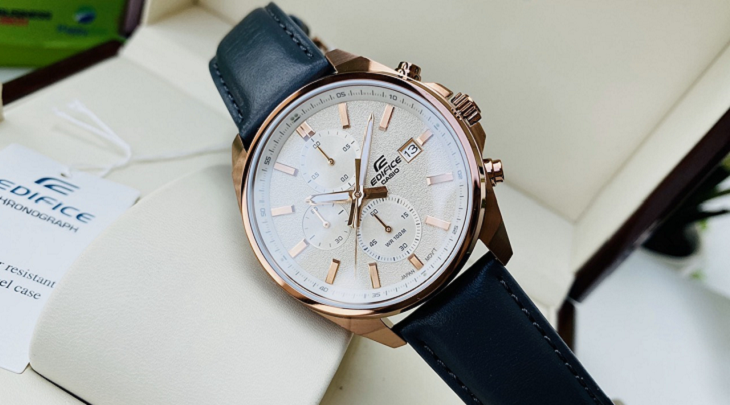Many people prefer and choose watches with leather straps. However, if you don’t know how to use and maintain them correctly, leather straps can easily become worn out and damaged. Let’s explore the proper way to care for leather watch straps and prevent damage with Mon Luxury – 1:1 Replica Watch!
The Importance of Properly Maintaining Leather Watch Straps
Watches made from leather are a top choice for many due to their practicality, sophistication, and impressive durability. However, improper usage and maintenance can cause leather straps to fade and crack. Therefore, properly maintaining leather watch straps is crucial.

When you maintain leather watch straps correctly, it provides several benefits, including:
- Increased durability: Proper maintenance helps extend the lifespan of your watch strap. While leather is known for its high durability, exposure to moist environments and inappropriate temperatures can cause it to fade and peel.
- Keeping leather watch straps looking shiny and new: Properly maintaining your leather watch strap will help preserve its shine and prevent color fading.
- Preventing moisture and unpleasant odors: Correctly storing your leather watch strap will prevent mold growth and keep it from developing unpleasant odors during use.
Types of Leather Straps and How to Properly Maintain Them
Currently, watch brands use three primary types of leather for watch straps:
- Simulated Leather Straps
Simulated leather is a synthetic material made from polyester fibers coated with 1-2 layers of PVC plastic. Simulated leather is stiff, challenging to clean, and prone to peeling and cracking when exposed to water or high temperatures.

Maintenance: When using simulated leather straps, avoid humid environments and contact with water, especially when it’s raining. Additionally, keep them away from direct sunlight and high-temperature areas. Use a soft cloth to wipe the strap when it gets dirty.
- PU Leather Straps
PU leather is similar to simulated leather but has an added layer of polyurethane for increased durability and a soft feel. PU leather can also peel and crack when exposed to humidity and high temperatures.
Maintenance: Regularly clean PU leather straps with a soft, dry cloth, and never use chemicals for cleaning. To ensure durability and beauty, avoid exposing these straps to high temperatures like direct sunlight or heat sources. When not in use, store them in a sealed box with a moisture-absorbing pouch.
- Genuine Leather Straps
Genuine leather watch straps are typically made from animal hides such as cowhide, calfskin, crocodile, or even ostrich. These straps provide a comfortable wearing experience but have limited water resistance.
Maintenance: Limit exposure to water, especially during rainy weather or when washing hands. In hot and humid climates like Vietnam, genuine leather requires careful maintenance as it can develop a patina, an unpleasant smell, and mold.
Properly maintaining your leather watch straps according to their specific type will help extend their lifespan and keep them looking their best.

3 Key Considerations for Leather Strap Care
When it comes to preserving your leather watch strap, there are a few principles to keep in mind:
- Avoid Water and Moisture: Don’t wear your leather watch when swimming or bathing to prevent it from quickly deteriorating or becoming moldy.
- Remove the Watch Before Sleep or Cleaning: Take off your watch before going to bed or engaging in household chores to ensure the leather strap remains breathable and lasts longer.
- Avoid Chemicals and Cleaning Agents: Refrain from allowing chemicals or cleaning agents to come into contact with the strap, as they can cause the leather to become damp and develop unpleasant odors.
- Ensure a Comfortable Fit: Don’t wear your watch too tightly, as this can cause creases in the leather strap.
- Regular Cleaning: To maintain your leather watch strap in the best condition, clean it every 1-2 months.

When to Replace Your Leather Watch Strap?
After some time of using a leather watch strap, if you notice the following signs, it’s time to replace it:
- Cracking and Discoloration: If the inside surface of the leather strap starts cracking or darkening, it’s advisable to get a new strap. Prolonged use of a damaged strap can harm your skin, potentially causing allergies. A damaged strap may also break at any time, leading to damage to your watch.
- Strong Odor: If your leather strap regularly comes into contact with moisture or gets wet without proper care, it may develop an unpleasant odor. In such cases, it’s best to replace the strap to continue using your watch comfortably.
- Mold or Excessive Dirt: During usage, if you neglect regular cleaning or fail to clean the leather strap properly, it may become moldy or accumulate excessive dirt. This not only affects the watch’s aesthetics but can also lead to skin irritation when worn.
Regular inspection and maintenance are essential to keep your leather watch strap in excellent condition and ensure your watch remains both functional and aesthetically pleasing.





